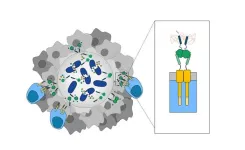Scientists unveil detailed cell maps of the human brain and the nonhuman primate brain
Incredibly detailed cell maps help pave the way for new generation of treatments
2023-10-12
(Press-News.org) A group of international scientists have mapped the genetic, cellular, and structural makeup of the human brain and the nonhuman primate brain. This understanding of brain structure, achieved by funding through the National Institutes of Health’s Brain Research Through Advancing Innovative Neurotechnologies® Initiative, or The BRAIN Initiative®, allows for a deeper knowledge of the cellular basis of brain function and dysfunction, helping pave the way for a new generation of precision therapeutics for people with mental disorders and other disorders of the brain. The findings appear in a compendium of 24 papers across Science, Science Advances, and Science Translational Medicine.
“Mapping the brain’s cellular landscape is a critical step toward understanding how this vital organ works in health and disease,” said Joshua A. Gordon, M.D., Ph.D., director of the National Institute of Mental Health. “These new detailed cell atlases of the human brain and the nonhuman primate brain offer a foundation for designing new therapies that can target the specific brain cells and circuits involved in brain disorders.”
The 24 papers in this latest BRAIN Initiative Cell Census Network (BICCN) collection detail the exceptionally complex diversity of cells in the human brain and the nonhuman primate brain. The studies identify similarities and differences in how cells are organized and how genes are regulated in the human brain and the nonhuman primate brain. For example:
Three papers in the collection present the first atlas of cells in the adult human brain, mapping the transcriptional and epigenomic landscape of the brain. The transcriptome is the complete set of gene readouts in a cell, which contains instructions for making proteins and other cellular products. The epigenome refers to chemical modifications to a cell’s DNA and chromosomes that alter the way the cell’s genetic information is expressed.
In another paper, a comparison of the cellular and molecular properties of the human brain and several nonhuman primate brains (chimpanzee, gorilla, macaque, and marmoset brains) revealed clear similarities in the types, proportions, and spatial organization of cells in the cerebral cortex of humans and nonhuman primates. Examination of the genetic expression of cortical cells across species suggests that relatively small changes in gene expression in the human lineage led to changes in neuronal wiring and synaptic function that likely allowed for greater brain plasticity in humans, supporting the human brain’s ability to adapt, learn, and change.
A study exploring how cells vary in different brain regions in marmosets found a link between the properties of cells in the adult brain and the properties of those cells during development. The link suggests that developmental programming is embedded in cells when they are formed and maintained into adulthood and that some observable cellular properties in an adult may have their origins very early in life. This finding could lead to new insights into brain development and function across the lifespan.
An exploration of the anatomy and physiology of neurons in the outermost layer of the neocortex—part of the brain involved in higher-order functions such as cognition, motor commands, and language—revealed differences in the human brain and the mouse brain that suggest this region may be an evolutionary hotspot, with changes in humans reflecting the higher demands of regulating humans’ more complex brain circuits.
The core aim of the BICCN, a groundbreaking effort to understand the brain’s cellular makeup, is to develop a comprehensive inventory of the cells in the brain—where they are, how they develop, how they work together, and how they regulate their activity—to better understand how brain disorders develop, progress, and are best treated.
“This suite of studies represents a landmark achievement in illuminating the complexity of the human brain at the cellular level,” said John Ngai, Ph.D., director of the NIH BRAIN Initiative. “The scientific collaborations forged through BICCN are propelling the field forward at an exponential pace; the progress—and possibilities—have been simply breathtaking.”
The census of brain cell types in the human brain and the nonhuman primate brain presented in this paper collection serves as a key step toward developing the brain treatments of the future. The findings also set the stage for the BRAIN Initiative Cell Atlas Network, a transformative project that, together with two other large-scale projects—the BRAIN Initiative Connectivity Across Scales and the Armamentarium for Precision Brain Cell Access—aim to revolutionize neuroscience research by illuminating foundational principles governing the circuit basis of behavior and informing new approaches to treating human brain disorders.
###
About the National Institute of Mental Health (NIMH): The mission of the NIMH is to transform the understanding and treatment of mental illnesses through basic and clinical research, paving the way for prevention, recovery, and cure. For more information, visit the NIMH website.
The NIH BRAIN Initiative is managed by 10 Institutes and Centers whose missions and current research portfolios complement the goals of The BRAIN Initiative®: National Center for Complementary and Integrative Health, National Eye Institute, National Institute on Aging, National Institute on Alcohol Abuse and Alcoholism, National Institute of Biomedical Imaging and Bioengineering, Eunice Kennedy Shriver National Institute of Child Health and Human Development, National Institute on Drug Abuse, National Institute on Deafness and other Communication Disorders, National Institute of Mental Health, and National Institute of Neurological Disorders and Stroke.
About the National Institutes of Health (NIH): NIH, the nation's medical research agency, includes 27 Institutes and Centers and is a component of the U.S. Department of Health and Human Services. NIH is the primary federal agency conducting and supporting basic, clinical, and translational medical research, and is investigating the causes, treatments, and cures for both common and rare diseases. For more information about NIH and its programs, visit the NIH website.
NIH…Turning Discovery Into Health®
END
ELSE PRESS RELEASES FROM THIS DATE:
2023-10-12
New York, NY—October 12, 2023—For several years, researchers have been successfully using chimeric antigen receptor (CAR) T cells to target specific antigens found on blood cells as a cure for patients with leukemia and lymphoma. But solid tumors, like breast and colon cancers, have proven to be more difficult to home in on. Solid tumors contain a mix of cells that display different antigens on their surface-often shared with healthy cells in the body. Thus, identifying a consistent and safe target has impeded the success of most CAR-T cell therapy for solid tumors at the first phase ...
2023-10-12
Tobacco is the leading cause of preventable death in the United States, according to the Centers for Disease Control and Prevention, and cigarette smoking causes three in 10 of all cancer deaths. Smoking also accounts for more than 30 percent of the difference in life expectancy among different socioeconomic groups.
Roberta Freitas-Lemos, research assistant professor at the Fralin Biomedical Research Institute at VTC, recently received a career development award to explore the ways in which nicotine tax policies can influence health disparities. The award of more than $680,000 over five years from the National Cancer Institute of the National Institutes of Health is designed ...
2023-10-12
New York, NY (October 12, 2023) - The Mount Sinai Health System has received a $12,180,625 grant from the National Heart, Lung and Blood Institute to compare new treatment options for sickle cell disease and determine which work best for specific patients.
“Sickle cell traditionally has been a neglected disease, but it benefited from a flurry of innovation over the last decade and there are now three new medications approved for the disease,” says Jeffrey Glassberg, MD, Director of the Mount Sinai Sickle Cell Program.
“While this is welcome news, clinicians now have a new challenge. ...
2023-10-12
Advocates for the use of trigger warnings suggest that they can help people avoid or emotionally prepare for encountering content related to a past trauma. But trigger warnings may not fulfill either of these functions, according to an analysis published in Clinical Psychological Science, a journal of the Association for Psychological Science.
Instead, warnings appear to heighten the anticipatory anxiety a person may feel prior to viewing sensitive material while making them no less likely to consume that content, wrote Victoria M. E. Bridgland of ...
2023-10-12
Researchers at Lund University in Sweden are investigating a car fuel comprised of a liquid that is converted to hydrogen by a solid catalyst. The used liquid is then emptied from the tank and charged with hydrogen, after which it can be used again in a circular system that is free from greenhouse gas emissions.
In two research articles, Lund researchers have demonstrated that the method works, and while it is still basic research, it has the potential to become an efficient energy-storage system in the future.
“Our catalyst is one of the most efficient around, at least if you look at publicly available research,” says Ola ...
2023-10-12
FROEDTERT HEALTH, WISCONSIN DIAGNOSTIC LABORATORIES AND HEALTHECO LAUNCH ATALAN, A TECHNOLOGY-ENABLED CLINICAL PARTNERSHIP PROVIDING ACCESS TO THE BEST IN LABORATORY MEDICINE
Atalan’s Access Hub Connects Doctors and Medical Centers to a Vetted Network of the Nation’s Foremost Clinical Laboratories to Improve Patient Diagnostics and Care
MILWAUKEE, Oct. 12, 2023 – Froedtert Health, Wisconsin Diagnostic Laboratories (WDL) and HealthEco announced today the launch of Atalan, a technology-enabled clinical partnership providing doctors and medical centers unprecedented access to a vetted network of the nation’s ...
2023-10-12
Researchers from the Veterinary Education, Research, & Outreach (VERO) program at the Texas A&M School of Veterinary Medicine & Biomedical Sciences (VMBS) have received $300,000 from the United States Department of Agriculture’s National Institute of Food and Agriculture to study the costliest disease in the cattle industry, bovine respiratory disease (BRD).
The grant will fund a highly collaborative project involving Mississippi State University, West Texas A&M University and Texas A&M ...
2023-10-12
A new study will combine an Alzheimer’s medication that slows disease progression in some patients with two other drugs to see if their effects can be amplified. The trial will be the first to test drugs acting on two disease-driving proteins, amyloid and tau, for patients with late-onset Alzheimer’s, the most common type of dementia.
The trial will recruit 900 participants with early Alzheimer’s at UC San Francisco and other sites nationwide. It is funded by a grant from the National Institute on Aging, part of the National Institutes of Health. It is awarded to Adam Boxer, MD, PhD, principal investigator and project ...
2023-10-12
Nearly 30 million Chinese individuals experience hearing loss (HL), with around 60% of these cases being hereditary. HL is the second most common congenital disability in China, with an estimated 30,000 babies in China born with HL each year and face the challenges of medical expenses and education-related issues.
To understand if concurrent hearing screening and high-throughput genetic screening could improve the effectiveness of newborn HL programs, a new study by Minghong Zhao, Xuemei Luo, Qinfei ...
2023-10-12
It may be possible to create paved roads and landing pads on the Moon by using lasers to melt lunar soil into a more solid, layered substance, reports a proof-of-concept study in Scientific Reports. Although these experiments were carried out on Earth using a substitute for lunar dust, these findings demonstrate the viability of the technique and suggest it could be replicated on the Moon. However, further work may be needed to refine the process, according to the authors.
Moon dust poses a significant challenge to lunar rovers as, due to the low levels of gravity, ...
LAST 30 PRESS RELEASES:
[Press-News.org] Scientists unveil detailed cell maps of the human brain and the nonhuman primate brain
Incredibly detailed cell maps help pave the way for new generation of treatments


